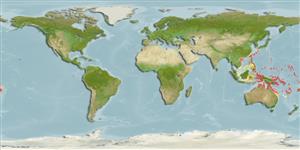>
Gobiiformes (Gobies) >
Gobiidae (Gobies) > Gobiinae
Etymology: Trimma: Greek, trimma, -atos = something crushed (Ref. 45335); capostriatum: Species name is presumably from the Latin 'caput' meaning head, end or point and 'striatus' meaning striped; referring the in referring to the alternating red and charcoal-blue stripes on the head (Ref. 100726).
Environment: milieu / climate zone / depth range / distribution range
Ecologia
marinhas associadas(os) a recifes; intervalo de profundidade 1 - 22 m (Ref. 100726). Tropical
Southwest Pacific: Australia (GBR), New Caledonia, Vanuatu, the Solomons, the Bismark Archipelago, northern and southern New Guinea and Palau (Helen Reef).
Tamanho / Peso / Idade
Maturity: Lm ? range ? - ? cm
Max length : 2.9 cm SL macho/indeterminado; (Ref. 100726)
Descrição suscinta
Chaves de identificação | Morfologia | Morfometria
Espinhos dorsais (total) : 7; Raios dorsais (total) : 8 - 10; Espinhos anais: 1; Raios anais : 8. This species is distinguished by the following characters: presence of a deep trough in the bony interorbital region about half pupil-diameter in width; with a shallow trough behind the eye along the upper half of the posterodorsal margin of the eye; naked predorsal midline, sides of nape is scaled to just behind the eye; no scales on cheek and opercle; the pelvic fins is connected by a basal membrane reaching to the tips of fifth ray, forming an indented plate; central 4-11 pectoral rays are branched; 5-6 light stripes (orange to red in life) on head and with dark blue interspaces, the body light with distinct scattered oval or round spots (yellowish-orange, orange or reddish in life); the snout is mostly darkly pigmented without distinct stripes in preserved material, but with orange stripes in life; the upper lip largely dark, except posteriorly, usually with orange stripes from the eye obscured by dark pigment on the jaws; uniformly dark lower lip; lower surface of the head with a black curved stripe and with a median black bar connecting to the lower lip; branchiostegal membranes are predominantly light, except for the stripe and the inner margin of the membranes (Ref. 100726).
Common on middle and outer reefs (Ref. 100726).
Ciclo de vida ou comportamento de acasalamento
Maturities | Reprodução | Spawnings | Egg(s) | Fecundities | Larvas
Winterbottom, R. and D.F. Hoese, 2015. A revision of the Australian species of Trimma (Actinopterygii, Gobiidae), with descriptions of six new species and redescriptions of twenty-three valid species. Zootaxa 3934(1):001-102. (Ref. 100726)
Status na Lista Vermelha da UICN (Ref. 130435)
Ameaça para os humanos
Harmless
Uso pelos humanos
Ferramentas
Relatórios especiais
Baixar XML
Fontes da internet
Estimates based on models
Índice de diversidade filogenética (Ref.
82804): PD
50 = 0.5000 [Uniqueness, from 0.5 = low to 2.0 = high].
Bayesian length-weight: a=0.00708 (0.00333 - 0.01504), b=3.09 (2.92 - 3.26), in cm total length, based on LWR estimates for this (Sub)family-body shape (Ref.
93245).
Resiliência (Ref.
120179): Elevada, tempo mínimo de duplicação da população menor que 15 meses (Preliminary K or Fecundity.).
Fishing Vulnerability (Ref.
59153): Low vulnerability (10 of 100).
